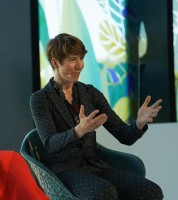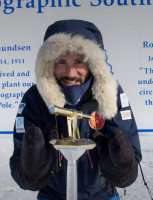Source : The Conversation
In places where municipalities continuously fail to collect and manage waste, authorities tend to concentrate their efforts in a few areas. These are often in a city’s wealthier sections. Informal settlements remain under-served or are not served at all. And so, waste accumulates.
Kampala, the capital of Uganda, is home to 1.5 million residents. It is growing at an annual rate of 5.1%. The expansion of cities like Kampala makes service provision difficult; infrastructure is poor and so are the roads that connect its neighbourhoods. About 87% of Kampala’s residents live in informal houses; 78% have access to electricity in their houses and only 17% have piped water. An estimated 1,300 tons per day of waste are produced in the city and about 50% is collected and transported to the landfill.
In this context, the absence of waste management and sanitation has led residents to come up with solutions to make usable products out of organic waste materials. One such innovation is producing energy briquettes from both organic and human wastes, or fecal sludge.
Marketing energy briquettes. By Shuaib Lwasa
Innovations emerge from the informal sector
Our research show that in cities such as Kampala, many individuals benefit economically from this informal sector, which also improves waste management services and addresses climate change.
Turning waste into a reliable source of energy is not new. Examples can be found in India, Bangladesh, Bolivia and many others. The waste-to-energy method is designed primarily as climate change mitigation to reduce emissions. But it also has huge potential to address employment problems.
This type of economic activity is not part of the official urban economic sector, yet it can greatly contribute to the economy. It requires innovation, community and business involvement and support from researchers. A small briquette-making business with semi-mechanised moulding machines would require an estimated 15 million UGX (about 3,700 euros) to capitalise.
In Kampala, we observed how this business model is being used to promote waste-to-energy in impoverished neighbourhoods to create jobs and expanded economic opportunities.
Tapping a free resource
Making energy briquettes from organic wastes is not new; this has been in production since the 1980s in Kampala. But there’s room for even more growth if businesses of this nature can grow to medium size. This can help in recovering uncollected waste materials from other neighbourhoods.
In Kampala, organic materials thrown away by residents include food waste, plant leaves and stems, fecal sludge. This material is collected by the groups, dried to reduce water, crushed and made into a char. The char is then mixed with a binder such as sawdust, dirt or clay with a little water and fed into a moulding machine that produces briquettes of different sizes and types. The briquettes are then dried to reduce the moisture and packed for sale.
Seasoning energy briquettes. By Shuaib Lwasa
Organic solid wastes produce greenhouse gasses when they decompose. So businesses that reduce the amount of waste going to landfills can cumulatively reduce greenhouse gas emissions.
Booming “waste” labs in the slums
We worked with NGOs such as ACTogether (affiliated to Slum Dwellers International) to identify informal settlements for piloting the businesses. We conducted a baseline study on the nature and quantities of organic waste, flows, waste types and major sources in the neighbourhoods. This was followed by consultations with 10 community producing groups with an average of 15 members, both men and women, about the possibilities of scaling up the energy-briquette businesses.
We organised several meetings and training workshops covering topics of energy-briquette product development, business-plan development, branding and marketing as well as skills in bookkeeping and accounting. Community groups are at different levels in briquette making. Some were experienced and producing as much as one ton per week, while others were just starting out.
The different community producing groups will be seeded for capital acquisition of fabricating machines, carbonising stoves, crushers and seasoning racks. Established groups, meanwhile, will require solar dryers, product branding and marketing drives.
The producing groups have established laboratories in the slums to test the different ingredients before rolling the products out for sale. And one of the key sales pitches is the emissions reduction of the briquettes compared to charcoal.
A strong organisation
There are also some groups that collect and deliver the organic wastes to the fabricating groups. Some take it further, producing char that they sell to the groups that make briquettes. These back-end businesses are evolving, including hiring youths to collect organic wastes and transporting them to the production units. Front-end businesses involving community members and youth groups are also emerging, specialisation in producing char that’s sold to fabricators.
Briquette machine. Shuaib Lwasa,Author provided
The community groups are establishing cooperatives for collective marketing of the briquettes. The cooperatives are working on quality control and standardisation since the groups produce briquettes independently.
Briquette quality control involves looking at the ingredients used, the carbonisation, mixing ratios and types of wastes used as a binder. The binder determines the length of time that a briquette will burn and thus its calorific value – that is, the selling quality in comparison to competitor products such as charcoal.
Fecal sludge can provide jobs
More than 75% of the households in Kampala use pit latrines and only 13% are connected to the sewer network. This implies that only a small fraction of human waste is treated. An innovation has evolved where small businesses have been established to collect and transport human waste to treatment plants.
This emerging economic activity is creating jobs, which are growing from a small to medium scale of operation.
Women and youth groups have developed waste-collection businesses that use the gulper technology to empty pit latrines and transport materials to sewerage treatment plants using tricycles with small tanks.
Continuous monitoring of greenhouse gas emissions from production through use by households is important. Our team has established a protocol for tracking emissions through periodic measurement at all the piloting production units during production and a few households who are close by that use the briquettes for cooking.
The branding will also include the information on the greenhouse gas emissions produced when briquettes are burned, and how much is saved to mitigate climate change. The hope using this method is that users will adopt the use of briquette as individual responsibility toward saving the planet from warming further.
A reproducible initiative
The amount of greenhouse gases generated by Kampala is negligible, relatively speaking, at an estimated 200g per person and a total of 0.7 million tons of CO2 per year. But producing energy briquettes from solid organic waste is an innovation that can be adopted in other cities that are searching for alternative pathways to sustainability.
We are also working with youth groups that are interested in tapping the energy from fecal sludge by transforming it directly into energy briquettes. This process is still in its infancy compared to briquettes from solid organic waste. But it is worth looking at as we continue exploring pathways to sustainability that are inclusive, resilient and sustainable.
September 2019



